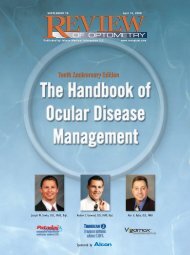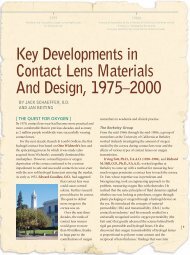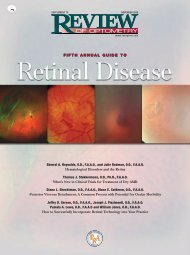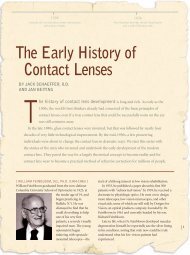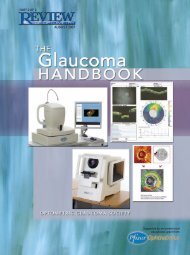Create successful ePaper yourself
Turn your PDF publications into a flip-book with our unique Google optimized e-Paper software.
Mid 50s<br />
Plastic <strong>Contact</strong> Lens Co (Wesley Jessen) and others make commercially successful PMMA lenses.<br />
Newton Wesley and George Jessen began an education campaign to teach their peers how to fit contact lenses.<br />
first American to fit the lenses in practice. <strong>The</strong> two were<br />
close friends for a while, although the friendship was<br />
strained by the legal wrangling that surrounded the<br />
transfer <strong>of</strong> Wichterle’s HEMA patents.<br />
Dr. Morrison was eager to have the patents in order<br />
to continue his own work with s<strong>of</strong>t contact lenses, but<br />
he was forced to share them with a group called the<br />
National Patent Development Corporation (NPDC).<br />
it,” said Dick Thornburgh, former U.S. Attorney<br />
General, former Governor <strong>of</strong> Pennsylvania, and a<br />
longtime patient <strong>of</strong> Morrison’s.<br />
Dr. Morrison enjoyed a long career treating patients,<br />
lecturing and teaching. He recently published a book<br />
about his life and career. 4 “I wrote it for my<br />
grandchildren,” Dr. Morrison said. “I wanted to make<br />
sure they got the facts straight when they hear some <strong>of</strong><br />
the tall tales about their grandfather.”<br />
8 |<br />
<strong>The</strong> NPDC bought out Morrison’s share soon thereafter<br />
and eventually licensed the technology to Bausch &<br />
Lomb, which refined it and brought the first s<strong>of</strong>t<br />
hydrogel contact lens, the S<strong>of</strong>lens (polymacon), to<br />
market in 1971. <strong>The</strong> FDA decided the lens was a drug,<br />
which created a major hurdle for B&L. Once past that<br />
hurdle, however, the company enjoyed a three-year<br />
monopoly on s<strong>of</strong>t contact lenses in the U.S., during<br />
which time it dominated the marketplace and PMMA<br />
became nearly obsolete.<br />
In addition to serving as the bridge between Otto<br />
Wichterle and the West, Dr. Morrison was a skilled<br />
contact lens fitter who truly had one <strong>of</strong> the first<br />
optometric practices to specialize in the young field <strong>of</strong><br />
contact lenses. He became known as the eye doctor <strong>of</strong><br />
the rich and famous, treating Hollywood stars and<br />
international royalty, and once received a Rolls Royce<br />
from Queen Juliana <strong>of</strong> the Netherlands as payment for<br />
his services. More than 40 years later, he still drives that<br />
car sometimes.<br />
“Dr. Bob has shown how much one person can<br />
contribute to the world during a lifetime, and how<br />
much fun and adventure he can experience while doing<br />
All <strong>of</strong> the individuals described here were pathcutters,<br />
charting a difficult way in completely unknown<br />
territory. <strong>The</strong>y laid the foundations for both rigid and<br />
s<strong>of</strong>t contact lenses and established a role for contact<br />
lenses in refractive correction that is now taken for<br />
granted. But in some ways, they raised more questions<br />
than they answered: What were the oxygen<br />
requirements <strong>of</strong> the cornea? Was there a material<br />
that would be comfortable and healthy over the long<br />
term? How long could contact lenses be worn? How<br />
should they be fit? How did one manage a contact<br />
lens practice?<br />
In future installments <strong>of</strong> this series, we’ll look at<br />
the people and the companies that refined lens<br />
material and design, built the manufacturing<br />
capabilities to revolutionize the industry, educated<br />
their colleagues about fitting, marketing, and the<br />
oxygen requirements <strong>of</strong> the cornea, and built the first<br />
contact lens specialty practices.<br />
1. Mandell RB. Historical development. In: Mandell RB. <strong>Contact</strong> lens<br />
practice. Springfield, Ill.: Charles C. Thomas, 1988:5-20.<br />
2. Kuwabara DM. <strong>History</strong> <strong>of</strong> the Cornea & <strong>Contact</strong> Lens Section,<br />
American Academy <strong>of</strong> Optometry website.<br />
3. Mertz GW. Development <strong>of</strong> contact lenses. In: Hamano, H and<br />
Kaufman H E. Corneal physiology and disposable contact lenses.<br />
Boston: Butterworth-Heineman, 1997:65-99.<br />
4. Knorr R, Kremer K. Man <strong>of</strong> Vision: <strong>The</strong> Story <strong>of</strong> Dr. Robert<br />
Morrison. Osprey, Fla.: SIS Publishing, 2006.<br />
[ SPECIAL THANKS ]<br />
Special thanks to contributors Robert Davis, O.D.; Art<br />
Epstein, O.D.; and Glenda Secor, O.D., for their assistance<br />
with this series.



